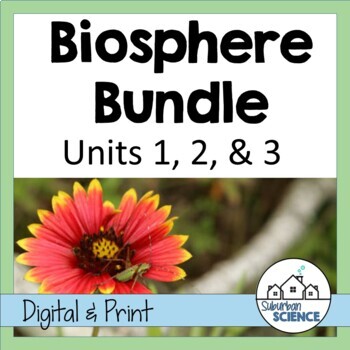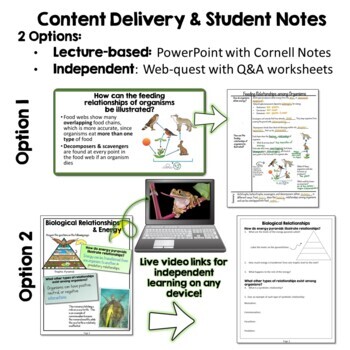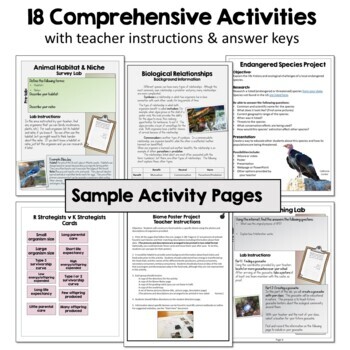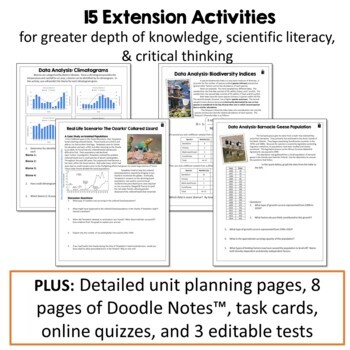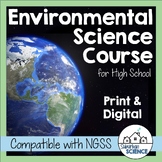Biosphere Bundle- Spheres of the Earth, Ecology, Communities, Biomes, Species
- Zip
What educators are saying
Products in this Bundle (3)
Also included in
- These environmental lesson plans will help your students to take charge of their learning! This comprehensive course is interactive, hands-on, and student-centered! Students learn about major environmental issues in modern society through detailed lessons and activities. Units cover the four sphePrice $250.00Original Price $276.00Save $26.00
Description
This bundle contains a month's worth of lessons, labs, and field activities and is perfect for an introduction to a high school environmental science course. The notes and projects are designed to facilitate independent learning and are ideal for sub plans or simply to encourage self-instruction of concepts. Activities and extension pages provide opportunities for class discussion and interaction while adequately preparing students in data analysis and graphing. Human impacts on the environment are interwoven through each lesson to provide students with a good basis for any environmental science or APES course.
All student pages come in both PRINT and DIGITAL versions for efficient use in class or through distance learning.
➤Included in this product:
-Detailed Teacher Planning Pages (standards document, editable daily pacing guide, differentiation ideas for student interest, ability, and learning environment)
-3 PowerPoints (66 colorful, animated slides)
-10 pages of Cornell Notes (both fill-in-the-blank and editable versions)
-8 web-quests with corresponding student questions
-8 pages of my popular Doodle Notes (TM)
-18 activities (projects, research, outdoor explorations, and group activities)
-15 extension pages focusing on critical thinking skills and math integration
-3 online quizzes through Google Forms
-14 editable task cards for a quick and easy unit review
-3 editable unit tests with multiple-choice and short answer questions (in both honors and regular versions)
-Supplementary Resource Ideas: links and videos for additional explanation or exploration
-Answer keys and grading rubrics for all student pages
➤What topics are included in this unit?
Spheres of the Earth
- Hydrosphere, geosphere, atmosphere, biosphere, cryosphere
- Interactions between spheres
- Biotic v. abiotic factors
- Organization of living things (organism, population, community, ecosystem, biome, biosphere)
- Habitat v. niche
Organism Relationships
- Herbivores, carnivores, omnivores, producers, scavengers, decomposers
- Food chains v. food webs
- Energy pyramid and trophic levels
- Conservation of energy and First Law of Thermodynamics
- Symbiotic relationships (mutualism, commensalism, parasitism, predation)
- Prey adaptations
- Definition of species
- Endangered v. threatened species
- Endangered Species Act
- Speciation (behavioral, mechanical, temporal, geographic)
- Interspecific competition
Populations and Population Growth
- Linear v. exponential growth
- Logistic growth
- S curve v. J curve
- Limiting factors (density-dependent and density-independent)
- Carrying capacity
- Natality, fecundity, fertility, mortality, life expectancy
- Survivorship curves (Types 1, 2, & 3)
- R strategists v. K strategists
- Age Structure Diagrams (Population Pyramids)
- 9 different world biomes (tundra, taiga, grasslands, deciduous forest, savanna, chaparral, rainforest, desert, alpine)
- Climate v. weather
- Climatograms (or climate diagrams)
Communities & Ecological Succession
- Keystone species
- Indicator species
- Primary v. Secondary succession, climax community, pioneer species
Biodiversity
- Types of biodiversity (species, genetic, ecological)
- Biodiversity index
- Sampling methods
- Invasive species
The unit is aligned to NGSS and many state standards. If you’d like to know whether your state standards are covered, you can send me an email at support@suburbanscience.com. Additional details on standards are included in the teacher planning pages of this course.
________________________________________________________________________
*For more details about the specific topics and items included, please see the PREVIEW for each lesson.*
________________________________________________________________________
➤New to teaching Environmental Science? Here’s how this unit will save you time:
1) The included NGSS, state standards, pacing guides, and differentiation ideas make lesson planning a breeze.
2) Multiple options for content delivery are included for built-in differentiation. Use web-quests for independent or 1:1 classes or use the PowerPoints and guided notes for classes that need more structure.
3) Student pages are compiled into one document that’s ready to print and copy all at once!
4) The PowerPoints coincide perfectly with the Cornell Notes pages, making lectures easy. The PowerPoints even have bolded terms that match the fill-in-the-blank Cornell Notes for error-proof student notes!
5) Teaching instructions, material lists, answer keys, student examples, and photos are all included so you’ll know exactly how to plan for and explain each activity to your students.
6) Editable PowerPoints, Cornell Notes, and assessments make it quick and easy for you to add or remove content to fit your standards and the needs of your class.
What curriculum could I use with these lessons?
This lesson is ideally geared towards high school students and would work well with a general level Environmental Science or Biology textbook. It addresses the following topics in AP Environmental Science (APES):
- 1.1: Introduction to Ecosystems
- 1.2: Terrestrial Biomes
- 1.9: Trophic Levels
- 1.10: Energy Flow and the 10% Rule
- 1.11: Food Chains and Food Webs
- 2.1: Introduction to Biodiversity
- 2.4: Ecological Tolerance
- 2.5: Natural Disruptions to Ecosystems
- 2.6: Adaptations
- 2.7: Ecological Succession
- 3.1: Generalist and Specialist Species
- 3.2: K-Selected and R-Selected Species
- 3.3: Survivorship Curves
- 3.4: Carrying Capacity
- 3.5: Population Growth and Resource Availability
- 3.6: Age Structure Diagrams
- 3.7: Total Fertility Rate
- 3.8: Human Population Dynamics
- 5.2: Clearcutting
- 8.2: Human Impacts on Ecosystems
- 8.4: Human Impacts on Wetlands and Mangroves
- 9.8: Invasive Species
- 9.9: Endangered Species
- 9.10: Human Impacts on Biodiversity
➤Teaching virtual students this year?
All student pages and presentations included in this unit are available in PRINT or DIGITAL through Google Slides™ to be completed at home or in a 1:1 classroom. Students can view the PowerPoint or web-quests at home, type on the pages, and even use Doodle Notes™! These digital pages work for any learning platform in which students can access Google Slides™ (Google Classroom™, Microsoft OneDrive™, Canvas™, etc). If you’re not sure whether the digital version will work for your students, just send me an email at support@suburbanscience.com and I can give you a free sample to test.
I have taught Environmental Science both in classroom settings and through homeschool courses. Although this course was not designed specifically for individual homeschool use, the materials and resources included can be easily found at home and/or completed in a virtual or homeschool setting.
➤Can I edit these resources to fit my needs?
Some of the files in this unit are editable. The text on the PowerPoints, Cornell Notes, and task cards is all editable so you can adjust the level of content and wording. The pacing guide, printable unit tests, and online quizzes through Google Forms™ are all fully editable. Web-quests, activities, extension pages, and any images included in this unit are in non-editable PDF formats to protect my intellectual property rights and those of the illustrators whose images I’ve purchased for use in this resource.
⭐For updates about sales and new products, please follow my store: My TpT Store
You can also
⭐Subscribe to my newsletter for freebies and teaching tips
⭐Follow me on Instagram
⭐Check out my Facebook page
⭐Follow me on Pinterest
I value your feedback. Please rate this product. If you have any issues or questions about this product, please feel free to ask a question in my store or write to me at support@suburbanscience.com.

